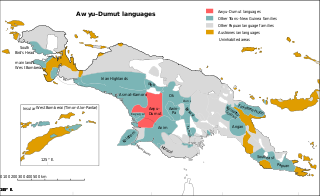
The Papuan languages are the non-Austronesian languages spoken on the western Pacific island of New Guinea, as well as neighbouring islands in Indonesia, Solomon Islands, and East Timor. It is a strictly geographical grouping, and does not imply a genetic relationship.
The Sko or Skou languages are a small language family spoken by about 7000 people, mainly along the Vanimo coast of Sandaun Province in Papua New Guinea, with a few being inland from this area and at least one just across the border in the Indonesian province of Papua.
The Sepik–Ramu languages are an obsolete language family of New Guinea linking the Sepik, Ramu, Nor–Pondo, Leonhard Schultze (Walio–Papi) and Yuat families, together with the Taiap language isolate, and proposed by Donald Laycock and John Z'graggen in 1975.
Donald Laycock (1936–1988) was an Australian linguist and anthropologist. He is best remembered for his work on the languages of Papua New Guinea.

The Torricelli languages are a family of about fifty languages of the northern Papua New Guinea coast, spoken by about 80,000 people. They are named after the Torricelli Mountains. The most populous and best known Torricelli language is Arapesh, with about 30,000 speakers.
The Kwomtari–Fas languages, often referred to ambiguously as Kwomtari, are an apparently spurious language family proposal of six languages spoken by some 4,000 people in the north of Papua New Guinea, near the border with Indonesia. The term "Kwomtari languages" can also refer to one of the established families that makes up this proposal.
The Left May or Arai languages are a small language family of half a dozen closely related but not mutually intelligible languages in the centre of New Guinea, in the watershed of the Left May River. There are only about 2,000 speakers in all. Foley (2018) classifies them separately as an independent language family, while Usher (2020) links them with the Amto–Musan languages.
The Border or Upper Tami languages are an independent family of Papuan languages in Malcolm Ross's version of the Trans–New Guinea proposal.
The Ramu–Lower Sepika.k.a.Lower Sepik–Ramu languages are a proposed family of about 35 Papuan languages spoken in the Ramu and Sepik river basins of northern Papua New Guinea. These languages tend to have simple phonologies, with few consonants or vowels and usually no tones.

The Sepik or Sepik River languages are a family of some 50 Papuan languages spoken in the Sepik river basin of northern Papua New Guinea, proposed by Donald Laycock in 1965 in a somewhat more limited form than presented here. They tend to have simple phonologies, with few consonants or vowels and usually no tones.
The Left May–Kwomtari or Arai–Kwomtari languages are a possible small family of Papuan languages proposed by Malcolm Ross, which links the Left May (Arai) family with the Kwomtari–Fas proposal. However, the proposal is problematic; it's not clear if the Arai correspondences are with Kwomtari, with Fas, or with both, as Kwomtari–Fas is itself dubious.
Nai or Biaka is a language of Papua New Guinea.

The Greater Awyu or Digul River languages, known in earlier classifications with more limited scope as Awyu–Dumut (Awyu–Ndumut), are a family of perhaps a dozen Trans–New Guinea languages spoken in eastern West Papua in the region of the Digul River. Six of the languages are sufficiently attested for a basic description; it is not clear how many of the additional names may be separate languages.

The Kamula–Elevala languages are a small family of the Trans–New Guinea languages spoken in the region of the Elevala River.

The Madang or Madang–Adelbert Range languages are a language family of Papua New Guinea. They were classified as a branch of Trans–New Guinea by Stephen Wurm, followed by Malcolm Ross. William A. Foley concurs that it is "highly likely" that the Madang languages are part of TNG, although the pronouns, the usual basis for classification in TNG, have been "replaced" in Madang. Timothy Usher finds that Madang is closest to the Upper Yuat River languages and other families to its west, but does not for now address whether this larger group forms part of the TNG family.

The Lower Sepik a.k.a. Nor–Pondo languages are a small language family of East Sepik Province in northern Papua New Guinea. They were identified as a family by K Laumann in 1951 under the name Nor–Pondo, and included in Donald Laycock's now-defunct 1973 Sepik–Ramu family.

The Senu River languages are a small language family spoken in the Senu River watershed of Papua New Guinea. They consist at least of the Kwomtari languages, Kwomtari and Nai, with several additional languages more distantly related to them.
The Ottilien or Watam-Awar-Gamay languages are a small family of clearly related languages,
Fas is the eponymous language of the small Fas language family of Sandaun Province, Papua New Guinea.
Kwomtari is the eponymous language of the Kwomtari family of Papua New Guinea.








